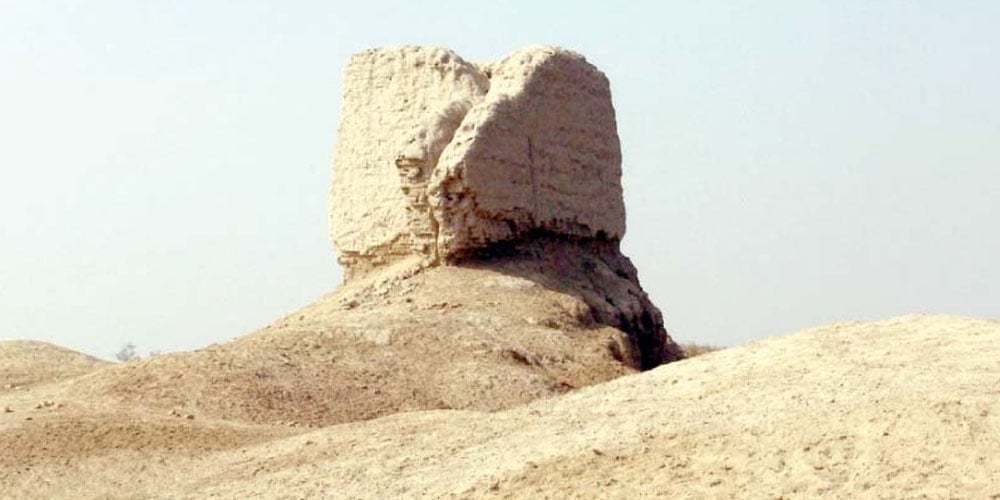
Punjab Department of Archaeology is excavating Dillu Roy in Dera Ghazi Khan, an ancient Buddhist site from the 1st century BCE.
According to APP, an archaeologist of the Punjab Archaeology Department has embarked on the maiden excavation of Mound Dillu Roy in Dera Ghazi Khan to uncover the treasure of historical secrets of the Buddhist era site is believed to be hiding underground.
The exercise is being undertaken for the first time ever in decades under an on-going Rs 17.323 million project with its first phase, meant to protect the site by a 6400 feet long boundary wall, stands almost complete.
“Despite having been plundered time and again and dug illegally, Mound Dillu Roy was still a rich site,” says Incharge Harappa museum, Muhammad Hassan, the only excavation expert of the department to undertake Dillu Roy assignment that would take almost 45-60 days to complete.
“We found structures at the depth of only six inches,” Hassan told APP last Monday. “These structures look like hailing from Gupta and Mughal period, however, further excavation and cleaning of remains would unveil exact detail.”
Leading around 50-men team comprising officials, draughtsman, photographer, and supervisors and equipped with small tools to delicately excavate the site, the archaeologist is in Jampur tahsil of district Dera Ghazi Khan since Jan 31 and has completed the process of contouring the site with a map plan indicating how to proceed forward.
The surface finds including antiquities, artifacts, clay pottery, coins, etc suggest Mound Dillu Roy be a 1st century B.C. to 2nd-century A.C site.
Famous travelogue writer and intellectual Dr. Abbas Birmani described Mound Dillu Roy, traditionally called Dillu Roy theatre, as a ‘speaking city asleep’ (Bolta Hua Khwabeeda Sheher), in his book ‘Tilismati Wadiyan’ (Magical valleys).
It was named after a prince Dillu Roy who had once ruled this area.
The mound is spread over 434 Kanal area, majority of it lying in DG Khan and only three Kanal in Jampur tahsil. It lies 2.5 miles North West of Jampur city on Jampur-Dajal road and consists of two mounds, roughly 100-150 feet apart. The larger one measuring 1460x800x15 feet marks the site of the city and the smaller one about 380 feet North-South, 950 feet East-West has been identified as the remains of a fort.
The only visible mud-brick structure on the surface is a British era watchtower, Hassan said.
Both the mounds had been dug by the local farmers and thus exposed the plan of houses and streets. The mud-brick walls have escaped complete destruction and some of the walls with traces of mud plaster stand as high as 12 feet. At certain places, a complete plan of rooms is traceable which varies from 5×5 feet to 15-10 feet. The study of the deep trenches dug by farmers has revealed two building periods of the city.
The archaeologist thinks the remains of ancient civilizations like Cytho Parthian period could be found at the bottom as they move forward with their vertical excavation
technique.
Hassan said, in addition to antiquities, the excavation process may lead them to remains of Cytho Parthian, Gupta, Kushan, Hindu Shahi, Tughlaq, Mughal and British periods.
However, he added: “Complete excavation would suggest whether we find remains of all or some of these civilizations.”
He said that excavation was time-consuming, and the delicate job was done in a scientific manner and at times archaeologists achieve only two-three inch excavations in a full day.
He said that contrary to metal or other objects, clay pottery remains intact underground for centuries, even millenniums. And pottery pattern denotes what period these belong to and the remains of structures indicate a pattern of streets, roads, homes, rooms, overall town planning, and lifestyle of the people of that era. Stratigraphy tells us what people habituated at what layer of the site.
He explained that pottery from 8000-1000 years old Indus Valley civilization had the same pattern, soil, motifs, structure whether found from Mohinjo Daro, Harappa or Mehergarh. Historically precious artifacts, coins, and other things collected from the Mound Dillu Roy surface were now kept at Harappa museum.
Dr. Abbas Birmani welcomed the Punjab government’s investment in an archaeological excavation and said: “It’s like a dream come true.” Pakistani landscape is a blend of scenic topography and historically important monuments depicting our heritage and we are proud of it, he added.
Read More News On
Catch all the Pakistan News, Breaking News Event and Latest News Updates on The BOL News
Download The BOL News App to get the Daily News Update & Follow us on Google News.



